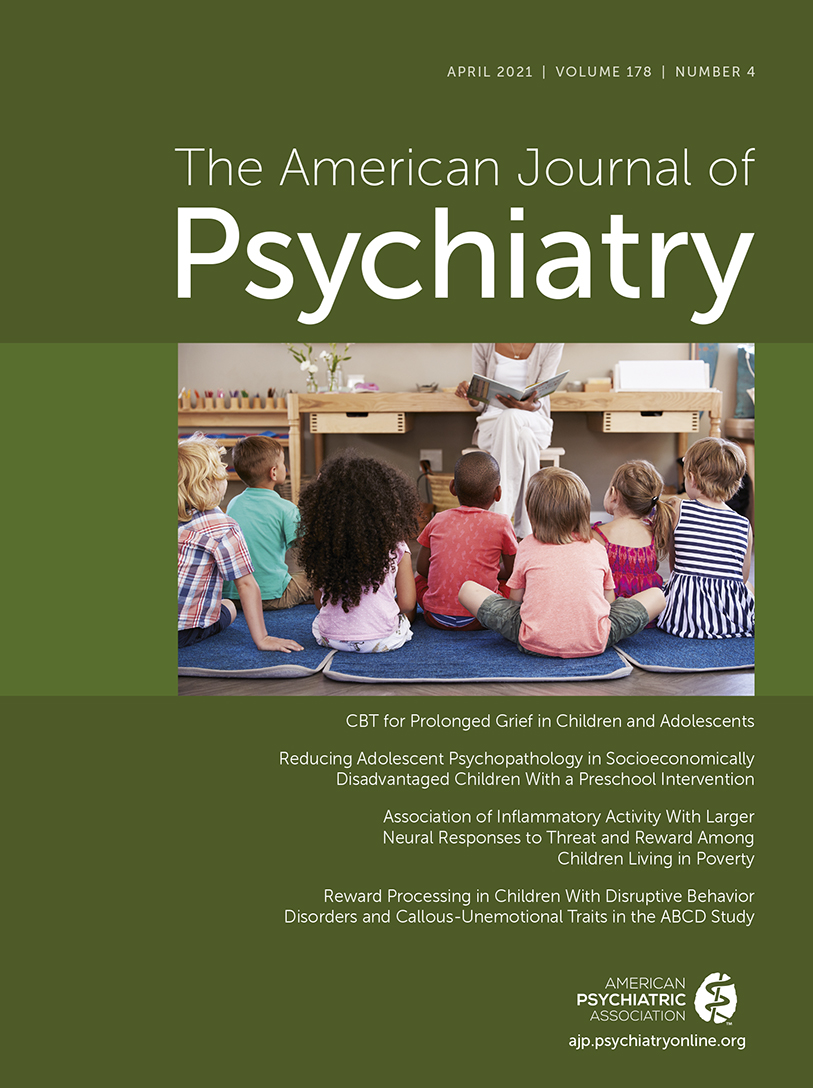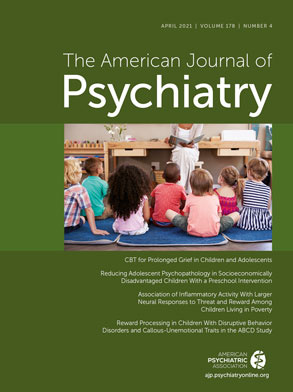In this month’s issue, Dwyer et al. (
1) report the results of a randomized crossover trial of single-dose ketamine compared with midazolam for the treatment of refractory depression in adolescents. This controlled trial follows reports of adult studies and of open trials or case series in adolescents suggesting ketamine’s value as a treatment for depression (
2,
3). The target of ketamine treatment has varied in these studies, ranging from refractory depression to severe depression symptoms with and without suicidal ideation. In addition to offering some hope to individuals whose illness is refractory to initial treatment, the rapidity of ketamine’s antidepressant effect addresses the protracted course for determining whether response and remission will occur. Clinicians, patients, and families struggle with how long it takes for antidepressants to work and, importantly, how long to wait for symptoms to improve before calling a treatment inadequate or ineffective (
4). This is a particular challenge for those with mood disorders with imminent suicidal risk, where the slow onset of antidepressant response creates a window of suicide risk for which we have limited treatment options. This study, by providing an initial signal of benefit, has the potential to change how we treat adolescents with depression.
The study is important in several areas. It explores the value of a novel treatment for adolescent depression. There is usually a long time lag between treatment advances for adults and studies in youths, and with the publication of this study, we are closing that critical research gap. The study demonstrates the feasibility of recruiting and randomizing participants from an arguably low-prevalence population, from the standpoint of clinical trials. It is often extremely difficult to recruit an appropriate sample of teens for depression studies. Teens are often too ill to ethically randomize to a placebo or are potentially not “ill enough” and respond too robustly to placebo (
5). While the phrase “well tolerated” may not be the best descriptor in characterizing the effects of ketamine, the good news is that the study did not identify any high-frequency or concerning adverse events, which should open the field for more studies of ketamine or similar agents in adolescents. Concern about ketamine’s psychotomimetic and potential addictive effects (
6) will persist until larger studies can demonstrate a robust safety profile.
That said, there are some significant limitations to this study, which readers should be aware of and which should lead to caution in interpreting the “efficacy” of ketamine in refractory depression in teens. First, the study sample was small, and small positive trials should always be viewed with some skepticism. Second, this is the first controlled trial of ketamine in teens to be published; first studies are often positive, especially if they have a small sample size and have enrollment goals met at a single site. More studies are needed to support clinically meaningful efficacy. Third, this was a crossover trial. While crossover trials are good for small samples of patients with low-prevalence conditions, they are not an ideal study design for treatments that have potentially durable effects that may or may not wash out, such as might be expected with a treatment like ketamine and for a condition like depression. While it did not appear that there were statistically significant order effects, it is possible that meaningful order effects would not be identified statistically, given the sample size. Fourth, this was a single-dose trial, which provides valuable information, but data past day 14 are not available, and little can be said about ketamine’s value in the longer-term clinical care of teens with refractory depression. Fifth, the study used blinded study personnel in the evaluation of benefits and adverse effects, but it was likely difficult to blind patients to the mood-altering effects of ketamine. Indeed, patients correctly identified ketamine as their treatment 100% of the time. One caveat is that study participants who experience a benefit (or in the case of ketamine, a mood change) in a blinded treatment study will often “guess” that they were on active treatment. The converse is also true; not experiencing a benefit, or, in the case of midazolam, not experiencing the expected benefit, may lead a participant to a “guess” of the control or inactive treatment.
The primary outcomes were traditional measures of depression—the Montgomery-Åsberg Depression Rating Scale (MADRS) and the Children’s Depression Rating Scale. While the supposition is that the mood change reflected in the change in MADRS score is a true change in depression symptoms, it is not clear whether the benefit of ketamine directly improves core mood symptoms or whether it offers a distinct mood experience that is viewed positively by the participants and reflected in mood ratings. It is possible that “a pleasing experience” with ketamine may offer participants a counter-experience to their depression symptoms. The participants in this study had been ill for an extended period and on average had failed to benefit from several treatment trials; demoralization was likely a contributor to their low mood. A positive short-term benefit from a mood-altering compound may have provided a physiological and psychological boost in mood and possibly reduced the participants’ sense of demoralization. Clearly, additional studies of the specificity and durability of ketamine’s effects over extended periods are needed. One more issue is that most of the study participants were on antidepressant treatment and could continue their current treatment. While response to antidepressant medication often occurs within the first 6–8 weeks, benefit can continue for upwards of 6–9 months, and late responses do occur (
7,
8). It is reasonable to attribute the mood benefit to ketamine, but it is not possible to rule out the chance of a synergistic (not independent) benefit of ketamine combined with current treatments as the cause of mood improvement.
What does this mean for the future treatment of teen depression? The authors should be applauded for this initial step toward improving outcomes for refractory teen depression. If teen studies show a trend similar to that we have seen in adult studies, we can expect to see 1) studies of longer duration with repeated ketamine dosing and longitudinal follow-up; 2) studies of youths who are at acute risk of suicide whether depressed or not, and whether refractory to past treatment or treatment naive; 3) studies of the use of non-intravenous ketamine formulations, such as oral or intranasal ketamine, to improve access to the benefits of ketamine in a variety of settings; 4) studies that attempt to measure the effects of ketamine on core symptoms of depression, such as anhedonia, or on the intense shift in anxiety observed in those at acute risk of suicide; and, lastly and perhaps most controversial, 5) the use of ketamine in treatment-naive patients who are at acute risk for suicide. Rapid mood improvement with reduction in suicide risk while waiting for traditional antidepressants to kick in would be a valuable tool in acute care settings.
There is some urgency to advancing this research agenda. We are currently in a COVID-19-related mental health pandemic. We entered the pandemic with rising rates of suicide across all child and adolescent populations, and the rates continue to rise (
9). Our mental health resources were limited before COVID-19 but became even more limited (
10) when, out of caution, intensive and acute care services restricted access further. While we must think broadly about improving access to mental health care for youths across the continuum of care, prioritizing innovative treatments like rapid-onset antidepressant medications to reduce acute suicide risk should be at the top of the national mental health agenda.

